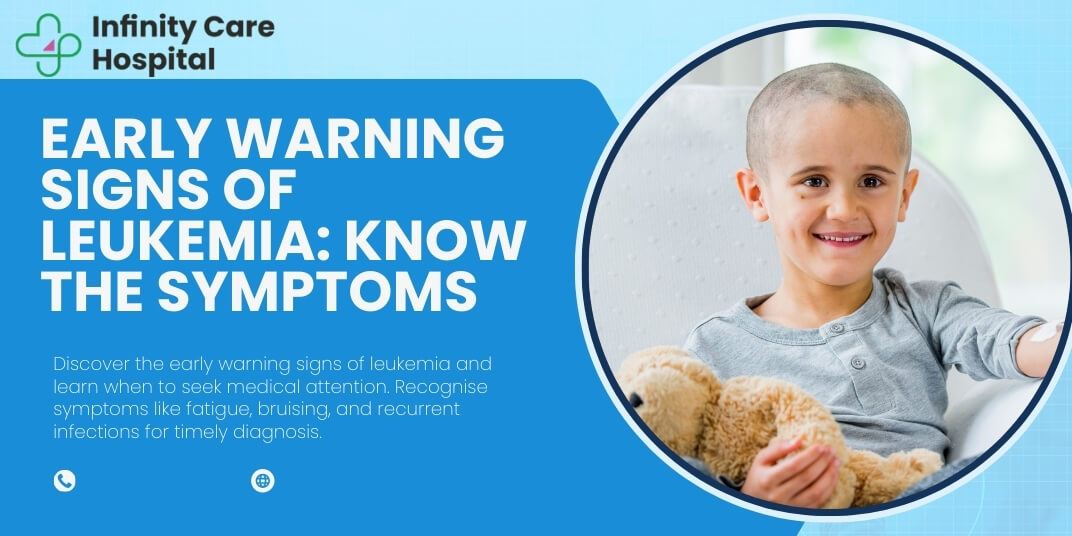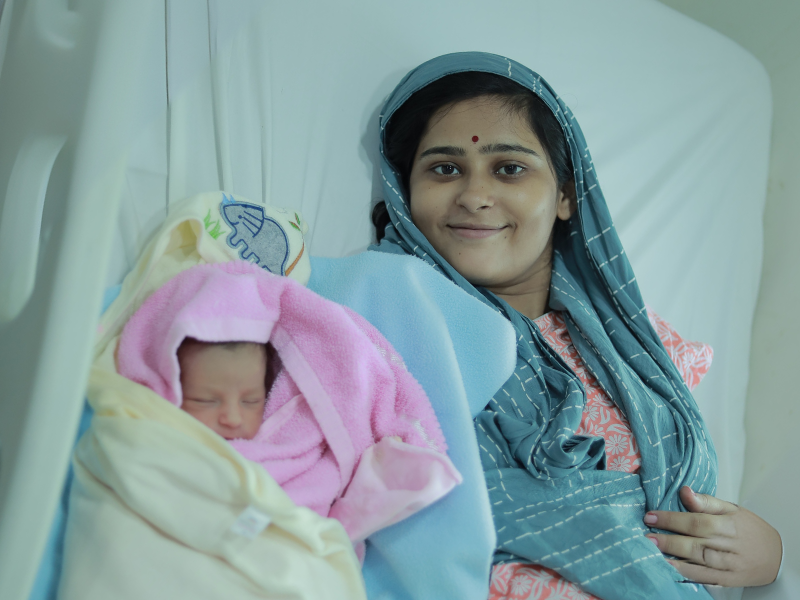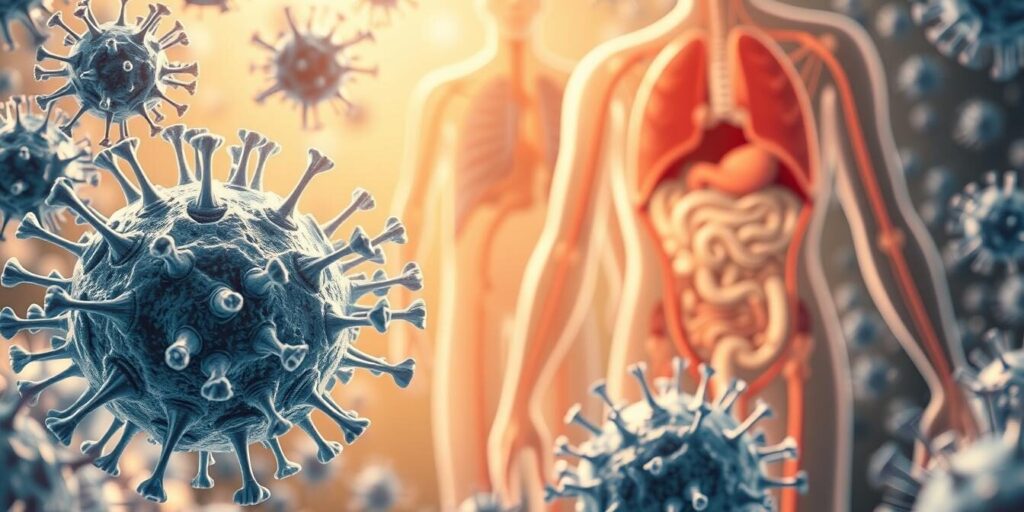Leukemia is a serious blood cancer that affects the body’s blood-making parts. This includes the bone marrow and the lymphatic system. It happens when there’s too much of abnormal white blood cells. This can make it hard for the body to fight off infections and leads to worrying symptoms.
Early signs of leukemia are often broad and can look like other common illnesses. It’s very important for people to get medical help right away if they keep getting the same symptoms.
Key Takeaways
- Leukemia can cause a variety of early warning signs, including fatigue, frequent infections, unexplained weight loss, and easy bruising or bleeding.
- Symptoms of acute leukemia, such as anaemia and shortness of breath, can develop rapidly and require immediate medical care.
- Chronic leukemia may present with more subtle signs, such as mild elevations in white blood cell count or enlarged lymph nodes or spleen.
- Risk factors for leukemia include exposure to certain chemicals, radiation, and genetic factors, making it important to be aware of potential triggers.
- Seeking prompt medical attention and undergoing appropriate diagnostic tests are crucial for the early detection and effective management of leukemia.
Understanding Leukemia: A Comprehensive Overview
Leukaemia is a cancer that starts in the blood-making tissues, like the bone marrow. It makes too many bad white blood cells. This pushes out the good ones. Knowing the types of leukaemia helps spot signs early and get help fast.
What is Leukaemia?
Leukaemia is a cancer that hits the blood-making tissues, like the bone marrow and lymphatic system. It makes too many bad white blood cells. This stops the body from fighting off infections, controlling bleeding, and moving oxygen.
Types of Leukaemia
There are several main types of leukaemia. They are split into two based on how fast they grow (acute or chronic) and the type of white blood cell affected (lymphocytic or myelogenous):
- Acute leukaemias grow fast and need strong treatment. Chronic leukaemias grow slowly and might not need treatment right away.
- Lymphocytic leukaemias affect lymphoid cells. Myelogenous leukaemias affect myeloid cells.
| Type of Leukaemia | Description |
|---|---|
| Acute Lymphocytic Leukaemia (ALL) | The most common childhood leukaemia, but can also occur in adults. |
| Acute Myelogenous Leukaemia (AML) | The most common acute leukaemia in adults, but can also occur in children. |
| Chronic Lymphocytic Leukaemia (CLL) | The most common chronic adult leukaemia, with individuals often remaining asymptomatic for years. |
| Chronic Myelogenous Leukaemia (CML) | Primarily affects adults, with patients potentially showing minimal to no symptoms over an extended period before entering a phase of accelerated growth of leukaemia cells. |
Knowing the different types of leukaemia is key to spotting signs early and getting help quickly.
Early Warning Signs of Leukemia
It’s vital to spot the early signs of leukaemia. The disease can mimic common illnesses, making symptoms hard to identify. If you notice any unusual signs, don’t hesitate to see a doctor. Key early signs include:
- Fatigue and loss of appetite
- Bone or joint pain
- Headaches
- Fever and chills
- Unexplained weight loss
- Night sweats
- Petechiae (small red spots under the skin)
Leukaemia types that grow quickly, like Acute Lymphocytic Leukaemia and Acute Myeloid Leukaemia, show clear symptoms. These include easy bruising, anaemia, and weakness. You might also feel dizzy, have shortness of breath, or experience bone pain.
On the other hand, chronic leukaemia types like Chronic Lymphocytic Leukaemia and Chronic Myeloid Leukaemia have milder symptoms. These can include tiredness, shortness of breath, and a decrease in appetite. You might also lose weight, have an enlarged spleen, or get infections often.
If you notice any of these signs, especially if they last for two weeks or keep coming back, get medical help. Early diagnosis is key to better treatment and outcomes for leukaemia patients.
| Acute Leukaemia Symptoms | Chronic Leukaemia Symptoms |
|---|---|
|
|
“Leukemia patients should seek medical attention if symptoms persist for two weeks without improvement or continue to recur with improvement between flare-ups.”
Common Symptoms of Leukemia
Leukaemia is a blood cancer that shows symptoms early if we know what to look for. These symptoms happen because abnormal white blood cells take over, leaving less room for healthy cells. Healthy cells help fight infections and keep us full of energy.
Fever or Chills
People with leukaemia often get fever and chills that don’t go away. This shows their immune system is not working right. These fevers can be hard to control.
Persistent Fatigue and Weakness
Feeling very tired and weak is a big sign of leukaemia. This is because there aren’t enough healthy red blood cells. Red blood cells carry oxygen around our bodies.
Frequent Infections
Leukaemia makes it hard for the body to fight off infections. This means people get sick more often, and it’s harder to treat these infections.
Unexplained Weight Loss
Leukaemia can also cause people to lose weight without trying. This happens because cancer cells mess with how our body works and how it uses energy.
It’s important to watch for these symptoms and see a doctor if they don’t go away. Knowing the signs early can help us stay healthy and fight the disease.
| Symptom | Description |
|---|---|
| Fever or Chills | Recurrent or persistent fever and chills, indicating a struggling immune system. |
| Persistent Fatigue and Weakness | Extreme and persistent fatigue, along with a general sense of weakness, due to lack of healthy red blood cells. |
| Frequent Infections | Weakened immune system leading to more frequent, severe, or persistent infections. |
| Unexplained Weight Loss | Unintentional and unexplained weight loss caused by cancer cells interfering with normal body functions. |
Paying attention to these common symptoms and seeking medical attention if they persist or worsen is crucial for the early detection and diagnosis of leukaemia.
Distinguishing Signs of Acute Leukemias
Acute leukaemias grow fast and show clear signs. These signs are important for early treatment. They help doctors act quickly.
Bruising and Bleeding Tendencies
One key sign is easy bruising and bleeding. People might get frequent or bad nosebleeds and bleeding gums. They might also see small red spots under their skin.
This happens because leukaemia messes with blood clotting. It affects how the body makes blood cells.
Anaemia and Shortness of Breath
Leukaemia can also cause anaemia. This leads to feeling weak, dizzy, and short of breath. It happens when leukaemic cells take over healthy red blood cells.
This makes it hard for the body to carry oxygen. It’s a big problem.
Spotting signs like leukaemia bruising and anaemia is key. These aggressive diseases need fast, strong treatment. Seeing a doctor early can help a lot.
Chronic Leukemia Indicators
Chronic leukemias are different from acute ones. They grow slower and may not show symptoms at first. Early signs can be a small increase in white blood cells or a slightly bigger spleen or lymph nodes.
Mild Elevations in White Blood Cell Count
A small rise in white blood cells is a sign of chronic leukemia. This is called leukaemia white blood cell count. It might not cause any symptoms, and doctors often find it during routine tests.
Spleen or Lymph Node Enlargement
Another sign is a bigger spleen or lymph nodes. This can be felt during a check-up. A leukaemia enlarged spleen or swollen lymph nodes might be the first thing you notice, even if you feel fine otherwise.
Even though chronic leukemia’s symptoms come on slowly, it’s crucial to see a doctor if you notice any changes. Catching it early and treating it quickly can make a big difference in how well you do.
Risk Factors for Leukemia
Leukemia is a blood cancer with several risk factors. Knowing these leukaemia risk factors helps in early detection and prevention.
Having had previous cancer treatment is a big risk. Some chemotherapy or radiation can lead to leukemia.
Genetic disorders like Down syndrome also increase the risk. These genetic disorders cause chromosomal problems that can lead to leukemia.
Being exposed to certain chemicals, like benzene, raises the risk. Benzene is in gasoline and used in the chemical industry. Smoking cigarettes also increases the risk of some leukemias.
Many people with leukemia have no known risk factors. This shows how complex the disease is. Regular health checks and watching for early signs are key for early diagnosis and treatment.
“Leukemia can affect anyone, but genetic counseling and testing can identify individuals at heightened risk due to genetic factors.”
In summary, main leukaemia risk factors are previous cancer treatment, genetic disorders, chemical exposure, and smoking. While these factors raise the risk, leukemia can also happen without them. Early detection and proactive healthcare are vital for managing this serious condition.
Early Warning Signs of Leukemia
Spotting the early signs of leukaemia is vital. It can lead to quicker diagnosis and better treatment. The symptoms might seem like other illnesses, but it’s key to watch out and see a doctor if they don’t go away.
- Fatigue and constant tiredness that doesn’t get better with rest
- Loss of appetite and unexpected weight loss
- Bone or joint pain
- Headaches
- Fever and chills
- Frequent infections
- Night sweats
- Petechiae (small red spots under the skin showing bleeding or bruising)
Not everyone with these symptoms has leukaemia. But, it’s important to check any lasting or worrying signs with a doctor. Catching it early is crucial. Quick treatment can greatly improve the chance of managing this serious disease well.
| Symptom | Explanation |
|---|---|
| Fatigue | Fatigue (tiredness that lasts a long time and doesn’t improve with rest) is a common symptom of leukaemia. |
| Bruising and Bleeding | Bruising and bleeding more easily, or bleeding that takes longer to stop, can be indicative of leukaemia. |
| Frequent Infections | Infections that are more frequent, severe, or last longer are common symptoms of leukaemia. |
| Fever | Fever (high temperature) can be a warning sign of leukaemia. |
| Weight Loss | Weight loss that is unexplained is a symptom that might indicate leukaemia. |
| Swollen Lymph Nodes | Swollen lymph nodes (glands in your neck, armpit, and groin) can be a sign of leukaemia. |
| Breathlessness | Breathlessness is another symptom that could point to leukaemia. |
If you or someone close is showing any of these leukaemia signs, get medical help right away. Early diagnosis and treatment can greatly improve managing this serious condition. While not all symptoms mean leukaemia, it’s always best to check with a doctor.
“The earlier leukaemia is diagnosed, the better the chances of successful treatment.”
Diagnosing Leukemia: Seeking Medical Attention
If you notice any symptoms that last or worry you, it’s key to see a doctor. They can run tests like blood tests and maybe a bone marrow biopsy. This helps figure out if you have leukaemia and what type it is. Getting a diagnosis early is crucial for the right treatment.
Leukaemia’s early signs can be tricky and might seem like other illnesses. But, don’t ignore them. A doctor should check any symptoms that keep coming back. Quick action can greatly change how the disease is managed and the treatments available.
| Statistic | Value |
|---|---|
| New cases of leukaemia globally in 2020 | 474,519 |
| Individuals living with leukaemia worldwide | Approximately 4 million |
| Leukaemia-related deaths in 2020 | 311,594 |
These numbers show why early leukaemia diagnosis and seeking medical care are so important. Being proactive and working with doctors can lead to better treatment. This can greatly improve your life and chances of recovery.
“Early detection and ongoing advancements in medical research have significantly improved outcomes for individuals with blood cancer.”
Your health is the most important thing. If you’re unsure or worried, reach out to your doctor. Make an appointment to get your symptoms checked out.
Treatment Options for Leukemia
Understanding leukaemia treatment options is key to making informed choices. Each treatment plan is unique, aiming for the best outcome for the patient. The goal is to achieve remission and improve quality of life.
Chemotherapy
Chemotherapy is a mainstay in leukaemia treatment. It uses strong drugs to kill cancer cells. This method tries to get rid of leukaemia cells while keeping healthy ones safe.
Targeted Therapy
Targeted therapies have become more common thanks to genetic research. They focus on specific genetic changes in leukaemia cells. This makes treatment more precise and effective.
Stem Cell Transplantation
Some patients might need a stem cell transplant. This involves replacing damaged bone marrow with healthy stem cells. These can come from a donor, helping the body make normal blood cells again.
Combining these treatments with supportive care has greatly improved leukaemia outcomes. Ongoing research brings new hope and better chances for survival.
“The key to successful leukaemia treatment lies in a multidisciplinary approach, tailored to the individual’s needs and the latest scientific advancements.”
Prognosis and Survival Rates
The outlook for leukaemia varies a lot. It depends on the type, age, health, and how well treatment works. Genetic changes and how fast the disease grows also play a big role.
Though leukaemia can’t be cured for everyone, many people live long and healthy lives after treatment. The latest figures show a 5-year survival rate of 67% for all leukaemia types.
| Leukaemia Type | 5-Year Survival Rate |
|---|---|
| Acute Myeloid Leukaemia (AML) | 31.9% |
| Acute Lymphocytic Leukaemia (ALL) | 72.0% |
| Chronic Lymphocytic Leukaemia (CLL) | 88.5% |
| Chronic Myeloid Leukaemia (CML) | 70.0% |
| Chronic Myelomonocytic Leukaemia (CMML) | 20% for CMML-1, 10% for CMML-2 |
Age also affects leukaemia prognosis. Older adults often face a tougher battle. But, your doctors can give you the latest on your chances and treatment plans.
“Treatment for all types of leukaemia can last several months or even years, depending on the type and severity of the condition.”
Conclusion
Leukaemia is a serious cancer that affects the body’s blood-making parts. It leads to too many abnormal white blood cells. The early signs can be hard to spot, but it’s key to see a doctor if symptoms don’t go away.
Knowing about leukaemia’s types, risks, and signs helps people spot it early. This way, they can get help quickly. Understanding this can make a big difference in fighting the disease.
Thanks to new treatments, many people with leukaemia are doing better. Working with a healthcare team is crucial. This helps find the best treatment for each person’s case.
As we learn more about leukaemia, staying alert and getting help fast is vital. This is especially true for those with the disease. Keeping up with new research in leukaemia is important too.
Early detection and quick treatment are key to beating leukaemia. Being informed and caring for one’s health is crucial. This helps patients and their families manage the disease and aim for a positive outcome.
FAQ
What are the early warning signs of leukemia?
Early signs of leukemia include feeling very tired and losing your appetite. You might also have bone or joint pain, headaches, and fever. Other signs are unexplained weight loss, night sweats, and small red spots under the skin.
What is leukemia and what are the different types?
Leukemia is a cancer that affects blood-making tissues. It leads to too many abnormal white blood cells. There are acute and chronic types, affecting different blood cells.
What are the common symptoms of leukemia?
Symptoms of leukemia include fever, feeling very tired, and getting sick often. You might also lose weight without trying and have small red spots under your skin.
How do acute and chronic leukemias differ in their symptoms?
Acute leukemias show symptoms like easy bruising and bleeding quickly. Chronic leukemias have milder symptoms that come on slowly. Sometimes, there are no obvious symptoms at all.
What factors can increase the risk of developing leukemia?
Risk factors include past cancer treatment, genetic disorders, and exposure to chemicals like benzene. Smoking also increases the risk. Yet, many people get leukemia without any known risk factors.
What should I do if I experience persistent or concerning symptoms related to leukemia?
If you have symptoms that worry you, see a doctor. They can run tests to find out if you have leukemia and what type it is.
What are the treatment options for leukemia?
Treatments include chemotherapy, targeted therapy, and stem cell transplants. Each plan is made just for you, based on your needs and health.
What is the prognosis and survival rate for leukemia?
Survival rates vary by leukemia type, age, health, and treatment response. While not curable for everyone, many people can live long with the disease.




